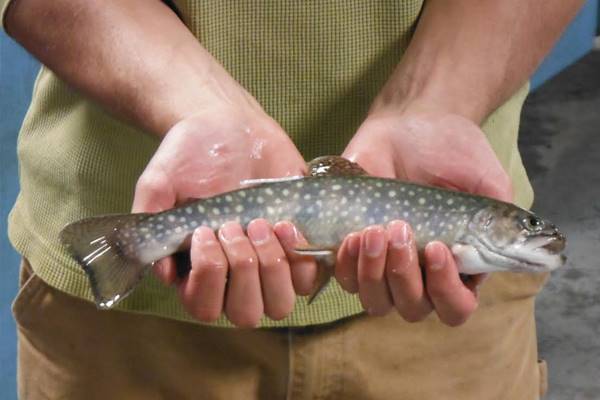Acoustic Tagging Effort May Reveal How Coaster Brook Trout Use Lake Superior
Managers at the Red Cliff Tribal Fish Hatchery in Wisconsin are preparing for a tracking study to figure out where coaster brook trout raised there are going after they’re released. Most of the fish are reared and then put into Lake Superior’s Buffalo Bay. But from there, hatchery managers aren’t really sure where they go.
To fill that gap in understanding, officials at the hatchery will be tagging coasters with acoustic tags. Hatchery managers will be able to track the fish when they swim past receiver buoys along stream mouths and other spots along Lake Superior’s shoreline. The work will yield data that will be used in-house to help restore populations of coasters in the lake.
Why Monitor Coaster Brook Trout?
“A long time ago, the populations used to be really high. But with overfishing and habitat loss, their numbers have dropped way, way down,” said Chase Meierotto, fish hatchery manager. “The populations are not great along the shoreline.”
Meierotto says that most of their efforts in that area involve electrofishing to see what sort of coaster numbers there are. But actually tracking the fish will provide more data than that typical method can provide.
The project is sort of on hold, he says, because there is some concern that the acoustic tag chosen for the fish is too large for them. To account for that, he and others at the hatchery are holding the trout to be released a little longer than is usual.
“Normally, we release most of our fish around 14 to 16 months, but we may release 2-year-old fish with these tags,” said Meierotto. “They grow a little slower while they’re in the tanks and we like to see them reach about 6 to 8 inches.”
But after the fish are released and the tracking effort is underway, he’s hopeful that the data gleaned from tracking them will be useful.
“We’re kind of in the dark, because we don’t do a lot of follow up work,” said Meierotto. “It will be interesting to see what we find and should give us a better idea of what’s going on.”

A 2-year-old coaster brook trout released a few years ago. (Credit: Red Cliff Tribal Fish Hatchery)
Conclusion
Not only will the findings benefit hatchery management there, but they could also help inform future restoration work concerning coaster brook trout populations in Lake Superior. This is because, Meierotto says, the tracking data will give insights to issues that the fish are facing once they leave the hatchery.
“Whenever we release our fish, everyone wants to know what’s happening to the fish, where they go, their success rate. Helping us track them better gets us a better idea of what’s happening to them after raising them in our hatchery,” said Meierotto. “It’ll help us figure out what we need to do to get populations back going in this area.” For example, he says, they could learn that they need to release larger, more mature trout if the fish are getting preyed on right away.
In addition, he would like to share data with other nearby fish hatcheries to get a more expansive idea of where the trout are going in Lake Superior. Managers at those hatcheries could also adopt some of the same methods in their parts of the lake, he says.
“If we were all using the same equipment, that could get us a good idea of how far the fish are traveling,” said Meierotto.
This story has been updated following the completion of this pilot study and follow-up research concluded in 2019. Read the updated story here.



0 comments